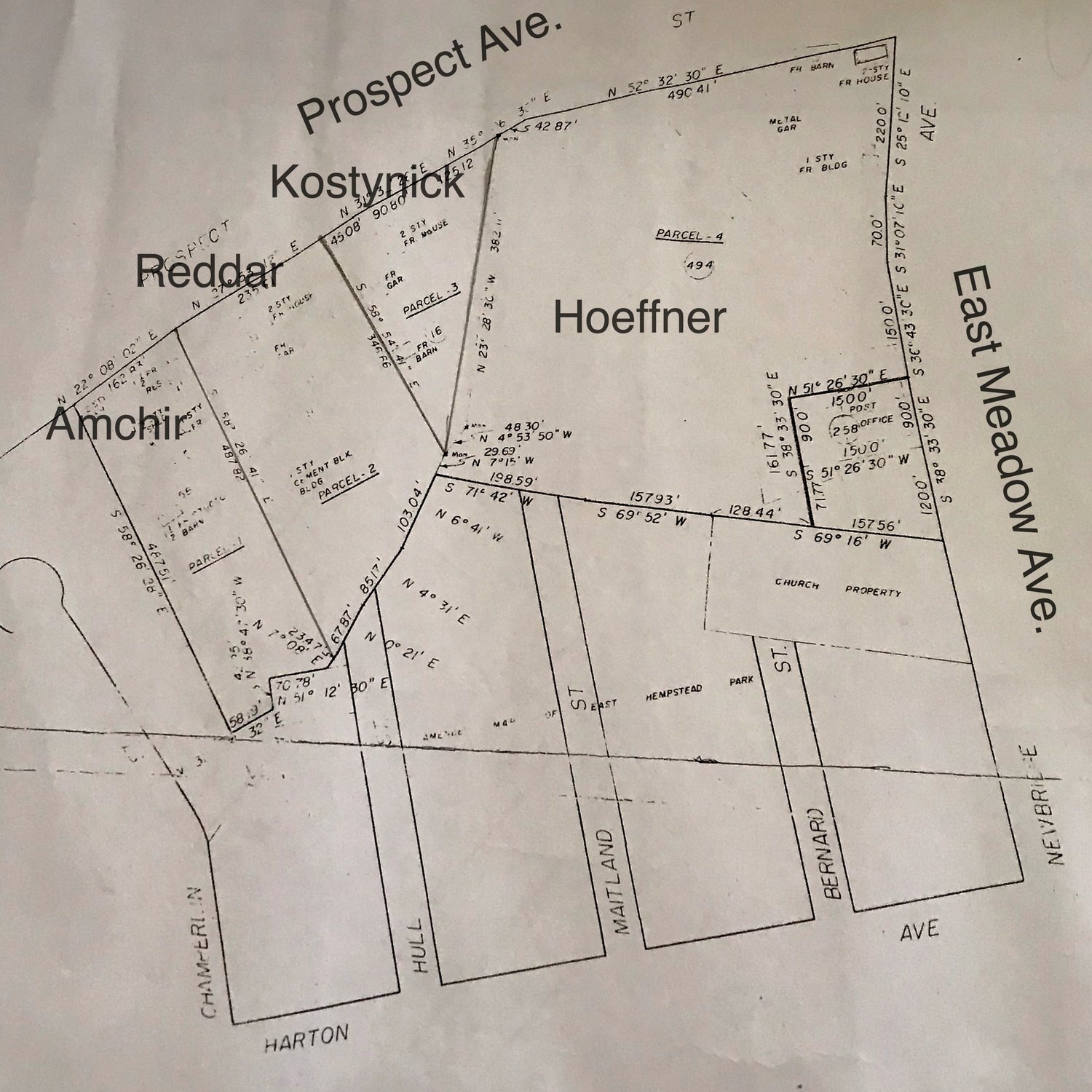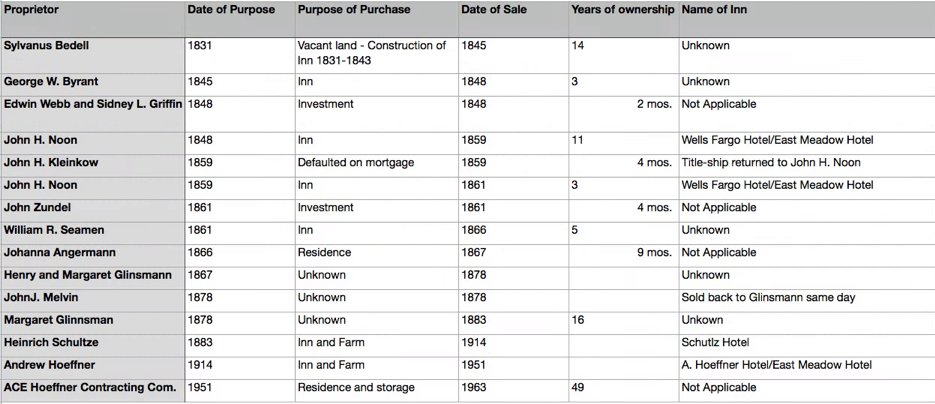Who really owned The Inn in East Meadow?
Sometime between 1831 and 1848 there was an inn constructed on southwest corner of Prospect Avenue (formerly Hay Carters Lane) and East Meadow Avenue (formerly, Newbridge Avenue) there stood an inn for circa 132 years. Throughout its lifespan only a few names today are known who operated it as an inn, however going back in time there were several more.
The table shows all owners throughout its history. Not much information is obtainable about Bedell. Byrant, Webb, Griffin, Kleinkow, Zundel, Seamen, Angermann, Glinsmann and Melvin, the table shows when they purchased it and years of ownership. However, more information is known during the ownership of Noon, Schultz and Hoeffner. Some owners were inn keepers, some used it as a residence and others used it as an investment.
John H. Noon purchased the inn on September 2,1848 from Webb and Griffin (an attorney and physician who purchased it as an investment). Noon, of Raynortown, (Freeport) lived most of his life in the Town of Hempstead. He married Mary Ann Van Pelt in 1845. John was brought up Methodist and didn't seem to be affected by the moralistic rules against consumption of alcohol, when purchasing the hotel serving alcohol. He later became a Episcopalian, the religion of his wife. Following the purchase of the inn, John named it the "Wells-Fargo Hotel”. In 1858 he donated a parcel of land on the East side of Newbridge Ave to the Methodist Episcopal Church upon which a small church was constructed. In 1897 a larger church was constructed which still stands today known as the Christ Alive Church. While living in East Meadow, Noon started speculating in real estate and purchased other inns in Plainedge and Farmingdale. He then sold the East Meadow inn in 1859. Today, the inn is located in the Old Bethpage Village Restoration bearing Noon’s name since the time frame of the village corresponds to the time frame of his ownership of the inn. John purchased an inn in Plainedge where he also proven to be a successful real estate speculator and became involved in animal husbandry selling horses and cattle. Once moved to Farmingdale where he purchased the Farmingdale Inn, he also donated a parcel of land on Conklin St. for the construction of the Episcopal Church. John and his wife, Mary Ann, are interred in the Bethpage Cemetery in Farmingdale.
Heinrich Schultz born in Germany, purchased the inn with his wife, Lena on June 8, 1883. The inn became known as the "Schultz Hotel”. Shortly after the purchase his wife died and in 1890 he married Adelina Hoffman. During the ownership of Schultz’s Hotel, the 1868 one-room school house (East Meadow Public School District #3) located where the library stands today on Front Street proved to be too small for the growing population of East Meadow and a new school was constructed. Heinrich Schultz consented to donate the use of his land to place the school on his property. The school was auctioned off for $41.00. It was then that the East Meadow Hall Association was established, a stock company divided into 1,000 shares at $1 per share. The fee was made nominal so that every resident could join and become a member. The school was then moved in 1896 by a team of horses to its new site on East Meadow Ave. (today’s location would be the parking lot of the post office). It was called the “East Meadow Town Hall," used for a public hall, polling place, Red Cross Center, Sunday school lessons and community events. Once its use for a public polling place in the mid 1940s was discontinued its title was reverted to the farmer who owed it at that time, Hoeffner. Later in the early 1960s the building was demolished for the construction of the parking lot of the post office. The original school bell was saved by Raymond Hoeffner, Sr., and donated to the East Meadow Public Library by the Hoeffner family in November of 2016, which was the original site where the school was located.
Andrew Hoeffner purchased the inn on Jan. 5, 1914 from Schultz.
Previously he farmed in Fosters Meadow, a German farming community, in an area today known as Elmont. It is unknown how long he ran the inn. It's assumed the reasons why he stopped running the inn might be he foresaw the advent of prohibition which started in 1920, forbidding the sale of alcohol or since Andrew and his wife Elizabeth had 9 children, they might have needed the space for their family. Andrew returned to farming and all seven sons and the two daughters worked on the farm. Throughout the course of the next forty years, their produce was brought by Andrew with initially a pair of horses and wagon and sold at the Wallabout Market (formerly the Brooklyn Navy Yard), in Brooklyn and other New York City markets. He would leave the evening before to be able to arrive at the market in the morning. Andrew purchased his first motorized vehicle in 1921, a Fulton truck, which was manufactured in Farmingdale, NY. Following his death in 1940, the land was then sold to his sons in 1951. Once World War II was over, the urbanization in Nassau County started to develop and East Meadow, what was once a small rural community became an area of housing developments replacing the open fields and farms. It was during this transformation that he Hoeffner brothers ceased to farm and then started the ACE Contracting Company, an excavation company. In 1950, the Hoeffners saw the need of a Post Office in the growing community of East Meadow and constructed the post office on Newbridge Avenue. Prior the mail was delivered from Hempstead by Walter Lowden, first mailman to deliver mail, via motorcycle from the Hempstead Post Office to East Meadow in what they called the “ Rural Route delivery”. Walter Lowden was from one of the oldest farming family Carman-Lowden located on Hempstead Turnpike. By 1955 all the Hoeffner children were married, living out on their own and the home was no longer used as a residence, it remained vacant, used for storage. The sons wanted to utilize the land where the inn was located. However, they realized the historical value of the house and did not want it demolished. In 1962, Clifford Hoeffner as spokesperson of the family offered the house free, along with $500 to remove and move the residence under the condition, that it was to be used as a museum. There had been initially interest of the East Meadow school district to purchase it however, the offer was never finalized. The structure and land remained in the Hoeffner family for 49 years.
As a side note, in 1963 the Town of Hempstead proposed the development of a town park. 4 parcels of land were acquired through “Eminent Domain” for the development of a “Veterans Memorial Park”. The Town of Hempstead then transferred the inn to the Old Bethpage Restoration Village. The structure was dissembled piece by piece and reassembled. It was noted that wooden dowels and not nails used during it's construction often seen in homes that were built in the 1800s
The 4 parcels of land acquired were, owned by the Amchir family, the Reddar family, the Kostynick family and the Hoeffner family, as seen on the map, Today, these combined parcels of land are known as Veterans Memorial Park, where there are swimming pools, tennis, handball and basketball courts plus playground and picnic tables. At the very tip of the corner where the inn was located is currently the “East Meadow Town Square," sponsored by the East Meadow Chamber of Commerce in 2000-2001.
Much of this research of the inn's history was provided by and I must share the credit to Richard Weinsche, Historian of the Nassau County Museum System. He shared with me much of this information and stories. Over the years, I had the opportunity to become friends Richard and learned a great deal of history from him.

 47.0°,
Fair
47.0°,
Fair 











